Air power has been an important part of naval operations for most of the last century, and today, it's where the USN has the bulk of its striking power. As such, it's worth taking a look at the weapons these aircraft use. We'll start with gravity weapons, which have no propulsion of their own. I'm going to focus this series on US weapons because that's what I have the most information on, and because I'd like to keep the scope reasonably contained.
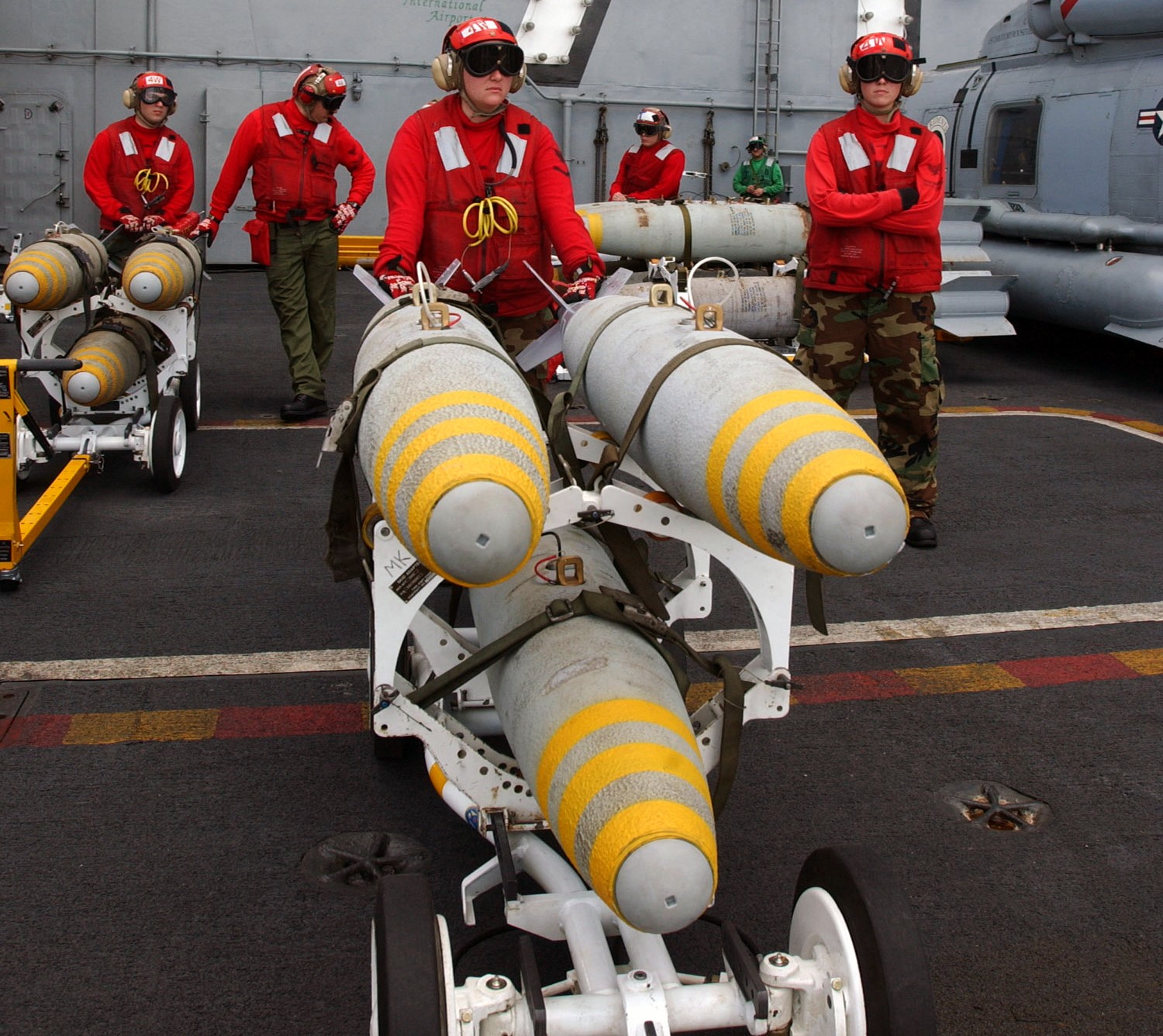
Mk 83 bombs waiting to be loaded on a carrier
The most basic of gravity weapons is the unguided (“dumb” or “iron”) bomb. It’s an aerodynamic steel shell, stuffed with explosives and fitted with tail fins to make sure it falls predictably and a fuze to set it off when it hits the ground. The standard American bombs are the Mk 80 series, comprising the Mk 82 (500 lb), Mk 83 (1000 lb) and Mk 84 (2000 lb). These are what is known as low-drag general-purpose bombs. Low-drag means that the shape was specially chosen for external carriage by high-speed combat aircraft, and they’re significantly more streamlined than earlier bombs. The B-52 was the last user of these earlier bombs, such as the 750 lb M117, which left service in 2015. "General-purpose" is because their combination of blast from the explosive and fragments from the bomb casing is effective against a wide variety of targets. These bombs are often described in terms of weight, but what does this weight mean? Is it the weight of the explosive or the bomb as a whole? In fact, it’s neither. The actual weight can be 10% or more greater than the official weight, while the explosive filling is 40-50% of the official weight.
But simple iron bombs are rarely used as such today. Instead, they form the foundation on which more complicated and more effective munitions are built. To some extent, this goes back to the early days of air warfare. Bomb fuzes would be tailored to maximize the effect against specific targets. For instance, when attacking troops in the open, a contact fuze might be used to make sure that the bomb didn’t bury itself in the ground before exploding. On the other hand, if you were trying to destroy a factory, a contact fuze would significantly reduce the effectiveness of the bomb. It would go off when it hit the roof, well above the workers and machines you were actually trying to destroy. Instead, you would fit the bomb with a delay fuze, so that it would penetrate the roof before it detonated. If you really wanted to make the other guy’s life interesting, you might fuze some of your bombs to hit the ground and do nothing, then go off minutes or hours later. Hopefully, this would make the task of cleaning up after your air raid much more exciting.
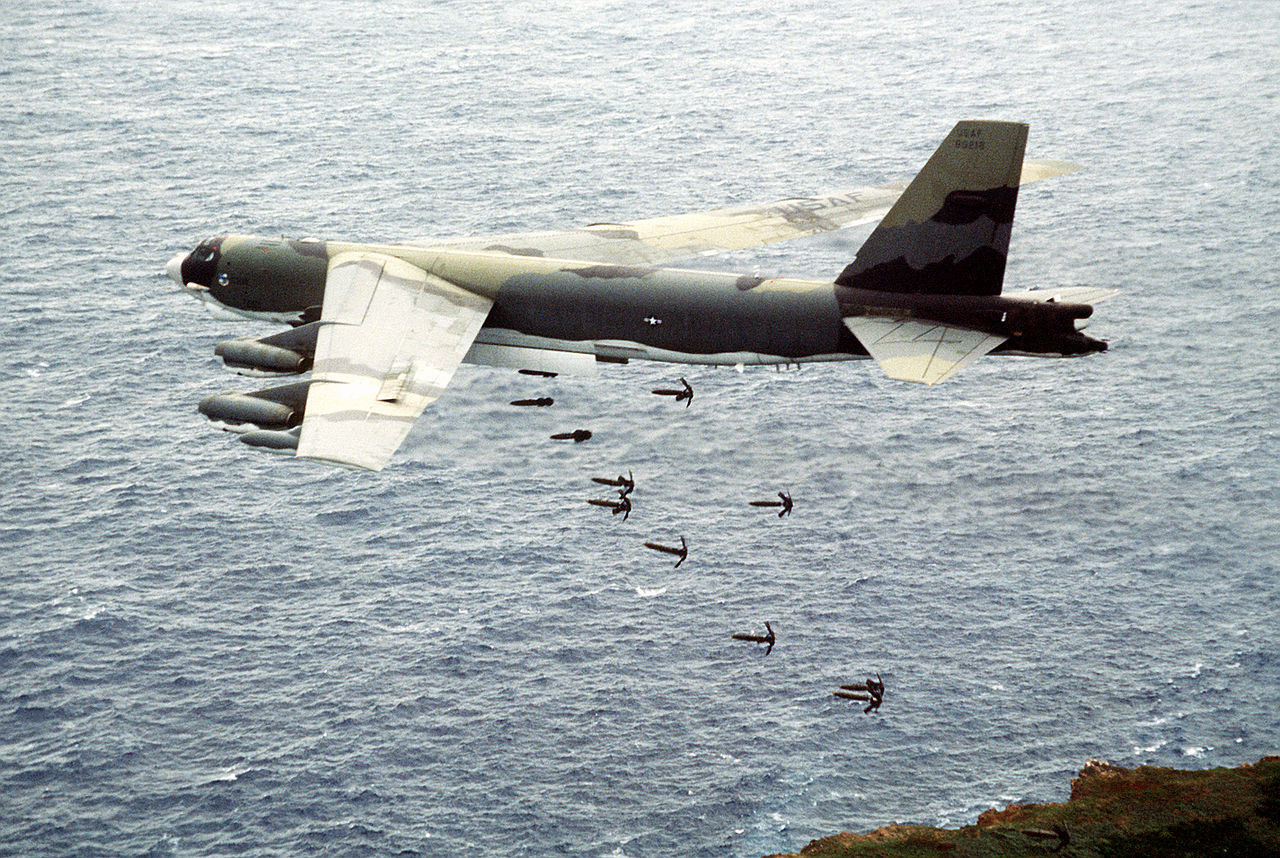
A B-52G drops Mk 82 Snakeyes
Nor are fuzes the only adaptable component of iron bombs. Low-altitude flight is often used as a means of avoiding air defenses, but attacking from low altitude raises a serious problem. Bombs keep moving forward when they’re dropped, and if the plane is low enough, it can be in the blast radius when low-drag bombs hit the target. This is obviously unhealthy, and the best solution is to fit the bomb with a retarding device which slows it down much more quickly than it normally would. These are usually parachutes or spring-loaded panels known as “Snakeye kits”.
But the ultimate problem with iron bombs is accuracy. During WWII, it would take 9,000 bombs dropped from medium altitude to get a 90% probability of hitting a target measuring 60’x100’. Improved avionics greatly reduced this number, to 176 bombs in Vietnam, but that still meant 44 sorties by fighter-bombers, and some targets are considerably smaller than 60’x100’. Flying at low altitude could help some, but the improved accuracy was compensated for by the increased chance of being shot down by guys with rifles and machine guns. Something better was needed, a guided weapon that could give precision accuracy from high altitude.
The idea of guided bombs was hardly new, of course. The first guided weapons to see large-scale use were the German Fritz-X and Hs 293, most famous for sinking the Italian battleship Roma, while the Allies made their own contributions to the field. But until the Vietnam War, guided weapons tended to be large, expensive, and not quite accurate enough for really tough targets like railway bridges. Something better was needed, and it came in the form of the laser-guided bomb (LGB).
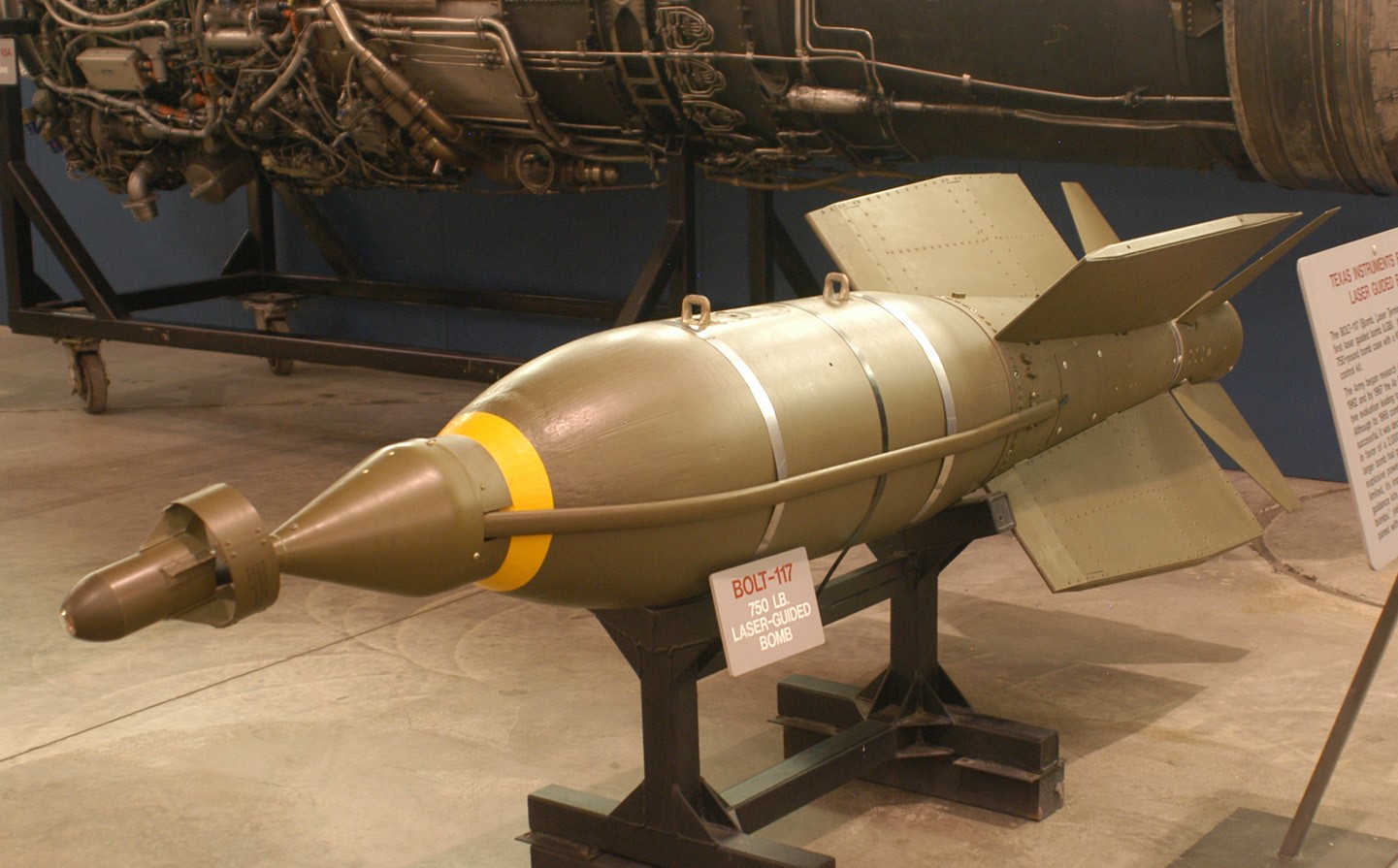
The first Paveway, BOLT-117
The idea of using a laser to guide a weapon originated in the early 60s, shortly after lasers left the labs and began to see operational use. The basic concept was quite simple. A laser produces light of a very specific frequency and can focus it tightly, making it easy for a seeker to detect it and follow it to a target. So long as the spot is on the target, the bomb will guide towards it, a more reliable method than other forms of guidance offered. The initial work on the concept, later named Paveway, was done by a team at Texas Instruments which went from concept to testing in 6 months at a cost of less than $100,000.1 Funds were so tight that the aerodynamics of the bomb were worked out in a swimming pool instead of a wind tunnel. But the resulting seeker and fins, when strapped to a Mk 82 or Mk 84 body, produced a weapon capable of getting within 30’ of the target about two-thirds of the time, for a cost of about $17,000 in 2019 dollars, about 15% of more typical guided weapons of the day. Suddenly, one aircraft could take out a target that had previously required an entire squadron of fighter-bombers, and with much less risk of collateral damage.
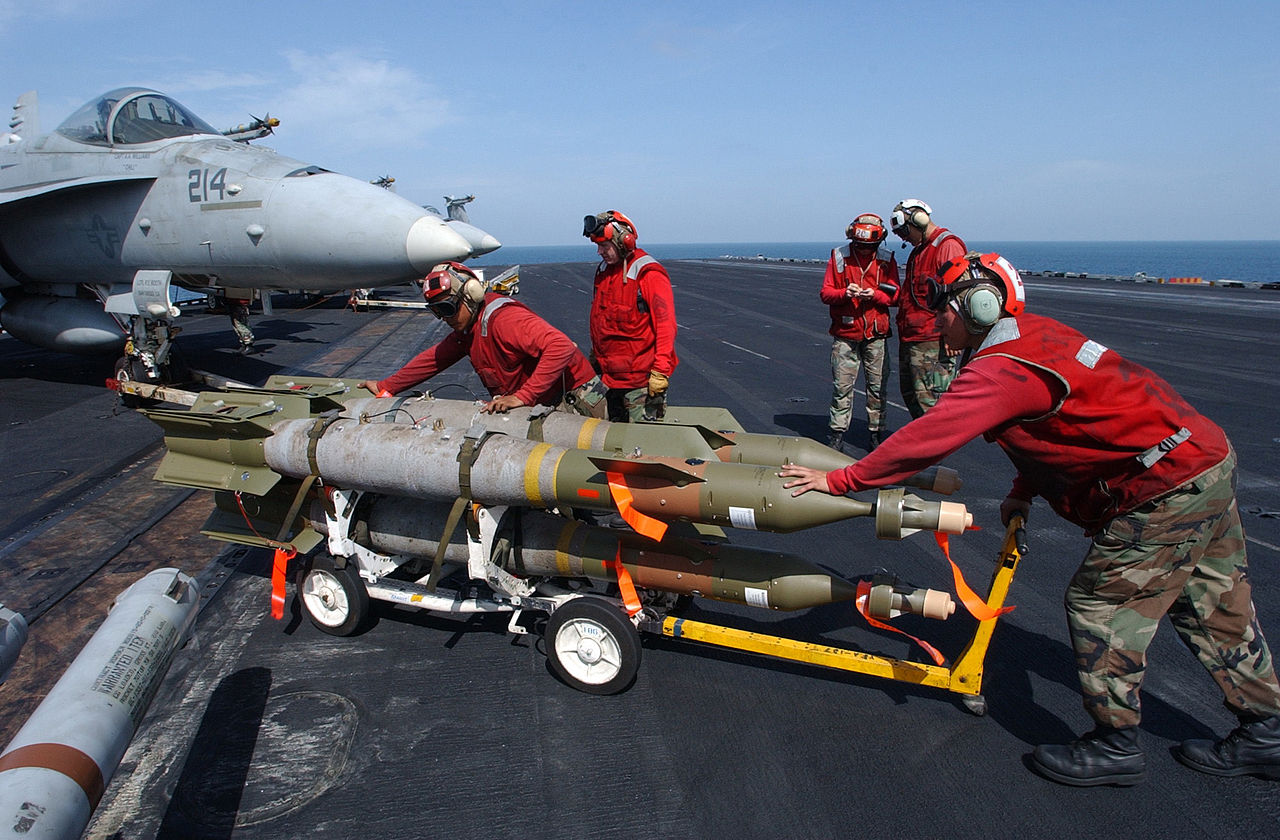
GBU-122 Paveway IIs being loaded aboard a carrier
Paveway wasn’t without limitations, but it was a very solid design, and a slightly improved version, Paveway II, entered service in the early 70s. The most obvious difference from Paveway I was that the fins in the rear of the bomb folded down, making it possible to carry two bombs on a standard pylon. The control was still the same, with the canards (front fins) doing the steering. Both versions used so-called “bang-bang control”, where the steering is either full or neutral. This is fine from the perspective of accuracy, but the trajectory it creates is far from optimal in terms of energy usage. Paveway II still has to be released very close to the ideal ballistic trajectory or it will run out of kinetic energy before it reaches the target, and the laser designator is often left off until the bomb is close to the target to prevent this from happening.
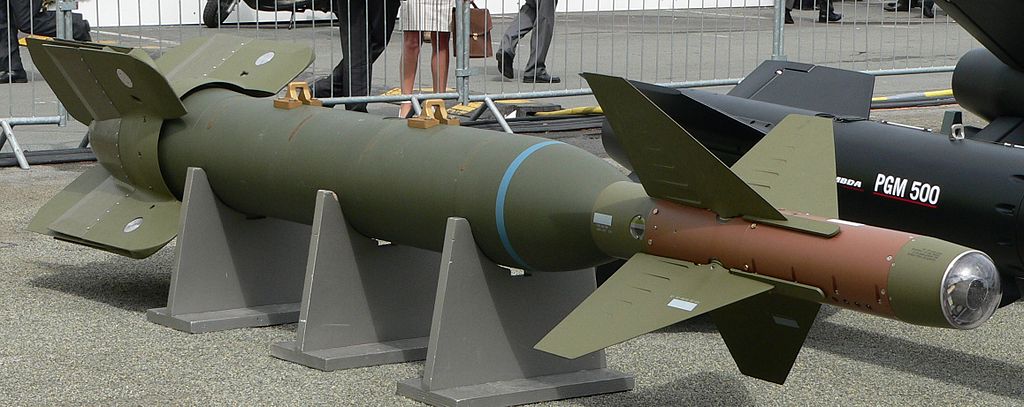
GBU-24 Paveway III with Mk 84 warhead
The limitations of Paveway II were apparent even as it was under development, and another program, ultimately called Paveway III, was started to try to overcome them. Paveway III uses a seeker with a wider field of view and proportional navigation logic, which steers a more energy-efficient trajectory. It can glide considerably further than Paveway II, allowing it to be released at low altitude, and the improved seeker results in greater accuracy than earlier LGBs. The main downside was that Paveway III kits cost enough that they have to be reserved for the most important targets, leaving Paveway II for less-critical missions.

A GBU-27 (BLU-109) Paveway III with fins deployed
The accuracy of Paveway opened up new options for targeteers. Previously, killing hardened bunkers had required the use of either nuclear weapons or truly enormous conventional bombs. But if the general-purpose warhead of an LGB was replaced with a bomb designed to penetrate concrete, then it might be possible to take out command facilities, hardened aircraft shelters, and other targets made with lots of reinforced concrete cheaply and effectively. The first of these weapons, the BLU-109, is a 2,000 lb bomb able to replace the Mk 84 as a warhead in most guided weapons built around general-purpose bombs. It can pierce 4-6 ft of concrete, a capability used to devastating effect during the Desert Storm air campaign. However, a few of Saddam's bunkers were too deep for even the BLU-109, and a crash program was begun to design and develop a new penetrator. Only three weeks after the initial design, the first bomb was dropped over Baghdad, the body of the bomb being fabricated from a surplus 8” artillery barrel. This weapon, called GBU-28 when mated with a Paveway III kit, can pierce over 15’ of concrete.
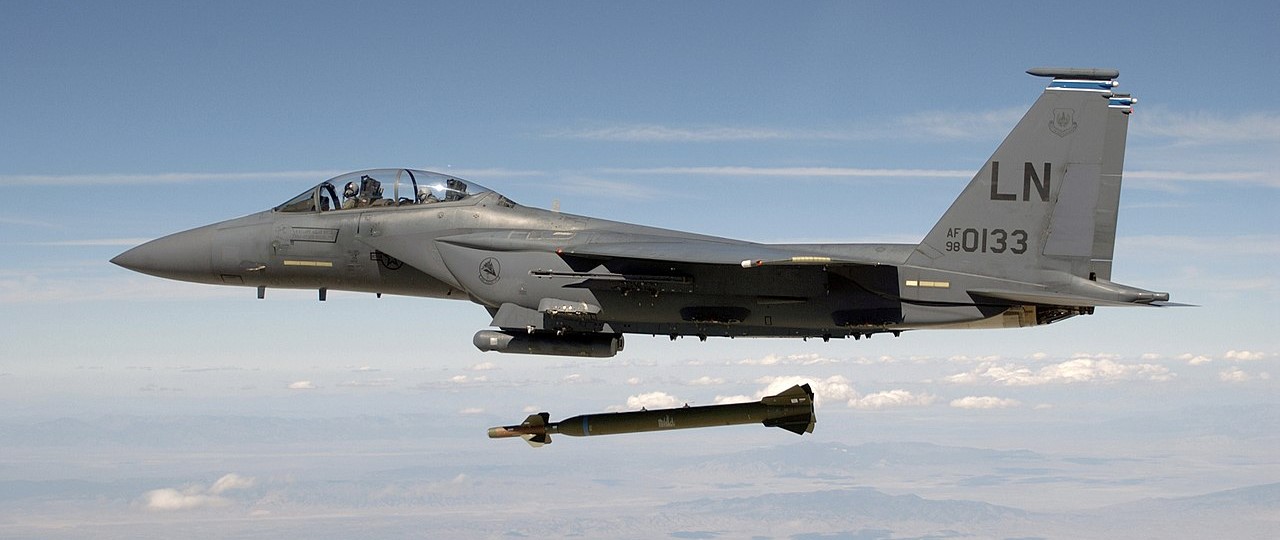
An F-15E drops a GBU-28
Another limitation revealed by Desert Storm was that laser-guided bombs are not particularly effective in bad weather. Sand, dust, rain and fog all block the laser and prevent the bomb from homing on the target. A program was started to try to address this, using a technology called GPS. The resulting weapon, known as JDAM, is the backbone of America's strike capability, and will be our subject next time.

Comments
What kind of targets would call for 'general purpose' bombs? The name does sound strange when guided weapons are so often the better choice.
Just about anything that's vulnerable to blast and fragments, which really means anything that isn't seriously hardened and thus in need of a BLU-109 or the like. Buildings? Troops? Vehicles? Airplanes? Ground equipment? All good targets. Note that back when these were invented and named, they didn't have guided weapons, and these days, most guided weapons are built around GP bombs.
Is there a reason Paveway was developed on such a small budget? It doesn't seem like a wacky long-shot idea or anything. Though I have heard that lasers were once seen as impractical technology...
(But whatever the reason, props to Texas Instruments)
Why are all the laser-guided bombs so... pinocchio-looking?
And who/what keeps the laser pointed at the right place?
@ADA
This was only a few years after lasers had left the lab, so a lot of people saw them as impractical. And they were trying to field quickly, so they used a program that gave $100,000 for projects that would help quickly, and apparently TI was unwilling to commit corporate funds. But that meant no more once it was all gone.
@Lambert
That's just how the seeker is designed. I don't really have full details on that bit, sorry. As for pointing the laser, that's the responsibility of whoever is operating the designator. Initially, this was the job of the backseater in a nearby aircraft. These days, they usually use a targeting pod, which has auto-tracking capability.
@Alexander: the name GP is really to distinguish them from the other types of bombs, which at least in the WWII RAF context (which is what I know about) were AP (armour piercing: a shaped charge for dropping on battleships and usually missing), HC (high-capacity: thin-cased blast bombs) and incendiaries.
Sometimes you'll see GP referred to as MC (medium capacity: i.e. more shrapnel and less bang than HC). Some bombs designated MC were definitely not "general-purpose", such as the Tallboy and Grand Slam earthquake bombs (for hardened targets like U-boat pens, underground targets, and things like viaducts that are so hard to hit that you want a near miss to be sufficient).
If you're Butch Harris trying to de-house Germans, what you want is a mixture of GP, HC and incendiaries. The HC blow in roofs and otherwise make buildings more flammable, the incendiaries start the fires, and the GP cause obstruction and hazard to anyone trying to fight the fires. This was a change from earlier in the war, when the targets were (in theory) individual factories, so the loads were mostly GP (bring down parts of the building with blast, and smash up machines and workpieces with shrapnel).
As for specific weapons, Bomber Command's usual GP was 500lb (although they did have a few 1,000lb, while the light bombers — think AASF — often used 250lb), the main HC was the 4,000lb 'blockbuster' (irreverently known as the 'cookie'), which was basically a cylinder without fins; ballistics aren't that important when your target is city-sized. The later 8,000lb and 12,000lb were not much more than two or three 'cookies' bolted together.
Incendiaries were mostly 4lb or 30lb, usually carried in boxes called SBCs (Small Bomb Containers) loaded to 1,000lb. There was also the "razzle", used in the summer of 1940 in an attempt to burn crops and forests (and typically carried as a secondary payload to be dropped on the way to or from the main target); this consisted of a piece of white phosphorus wrapped in damp cotton wool and sandwiched between two sheets of celluloid. When the cotton dried out, the phosphorus would ignite the celluloid. Razzle was unsuccessful, and also hazardous to deploy as the weapons had a nasty habit of going off while still on-board the aircraft. There were also a few cases of razzles falling on populated areas, where (allegedly) they were sometimes mistaken for propaganda leaflets and surreptitiously shoved into pockets to be read once home and out of the eye of the Gestapo — with results that can only be imagined.
The usual anti-ship AP was 2,000lb, though there was also the 5,600lb "capital ship bomb", which as far as I'm aware never managed to hit a capital ship.
@bean So "general purpose" can (and presumably usually does) refer to guided bombs? In which case, what kind of targets call for unguided bombs?
@ec429 That sounds like a thorough round up! Obviously AP shaped charges are still used by aircraft (always guided?). Do HC or incendiaries still have a role? They seem like the sort of thing that might not require guidance if used on area targets, but what kind of area targets are there now? Maybe a minefield?
@Alexander
ec429 did a better job of explaining this than I did. Basically, back in the old days, there were a lot of kinds of bomb, one of which gave reasonable capability against the most common types of targets. It became known as General-Purpose, and because a lot of modern guided bombs are built around old dumb bombs, it's still in use today. But it refers to the bomb (warhead) not the bomb (unit).
These days, the US almost never uses unguided bombs. Guidance is pretty cheap, and reduces the risk of collateral damage a lot, which is important. The other kind of bombs, except for penetrators, are largely phased out. Mass bombing of cities is out of style, and incendiaries are mostly retired due to changing attitudes towards the military use of fire. The spiritually successor of HC bombs are things like MOAB and Daisy Cutter, and most thermobarics, which use blast as their primary mechanism. But those are very niche weapons, particularly in this day of ever-increasing concern for collateral damage.
@ec429
An excellent summary, and I wasn't even aware of razzle. The one thing I would point out is that AP bombs weren't shaped charges. They were very similar to AP shells, and in at least one famous case were actually converted from 14" AP shells. The BLU-109 is a spiritual descendant, although optimized against concrete instead of steel. There was also SAP, essentially a hybrid between GP and AP. Probably the most common bomb for attacking ships. I think the slimmer shapes of modern GP bombs make them more effective at penetration than old GP bombs.
Is there any chance of putting the RTW posts in their own category? It's hard for me to find the older ones. Thanks!
They're all tagged. Look towards the bottom of the right sidebar.
The last major application of unguided bombs by the United States was various cluster bombs. Some targets, e.g. formations of troops or vehicles in the field, lines of aircraft parked on an airbase, are more effectively attacked by lots of small (~1 lb) bombs spread over a large area than by one large bomb even in the ideal location, because the large perfectly-aimed bomb can destroy only the one (tank, airplane, foxhole, whatever) it hits but the many bomblets can destroy many things. And if you're just trying to scatter bomblets across an area a few hundred meters across, you don't need laser precision and may not need any guidance at all.
But the best fuses we ever managed to fit in one-pound bombs were only about ~95% reliable, and the ones that didn't go off when they were supposed to, started acting like very erratic land mines. The very nice princess lady asked us to please stop doing that, and we basically said yes. A few thousand were used in the early stages of the war in Afghanistan, but I don't think any since.
Thanks for the explanations - are the bombs being built now constructed with integrated guidance, or as "iron" bombs that can be upgraded with kits? And if they don't come with guidance, is that because separate warheads and seekers are more flexible (e.g. easier to upgrade, or assemble a customised weapon) or because the bombs are being built to designs/on production lines that date back to the 70s? If they are modular because that gives advantages, might we see a similar trend with rockets and shells or the like?
@John - I just missed your comment, but it made me wonder if flechette based alternatives to cluster munitions would be worth guiding, or will they cover such a large area there would be little point?
@John
They kept using cluster bombs through the early stages of OIF, and there are still a few in inventory, but otherwise yes. Also, stop stealing points from my upcoming posts. Also also, WCMD was a thing.
@Alexander
The standard US guided weapon (JDAM) is built like Paveway, as a bolt-on kit for a standard iron bomb. This makes a lot of stuff easier. The fuze, guidance, and bomb shell are all independent, which makes engineering easier. Boeing, working on the guidance kit, just has to put the warhead at the right spot. They don't have to make it work. Likewise, fuze improvements are off in their own box. Want to stuff something else into the bomb body? Easy to do. Guidance doesn't care. It's also good for handling. The JDAM kits are just electronics, and you don't have to keep them in bunkers or magazines. Makes supply a lot easier, and cuts price.
This might or might not be changing. SDB, the most recent major weapon, has an integrated warhead, as well as a bunch of other features that would be hard to fit into an assembled weapon like Paveway or JDAM.
Re flechette bombs, they exist. The idea dates back to WWI, IIRC, and was most famously used as the Lazy Dog in Vietnam. The US has/had a version in service that was used against Iraq in 2003, but it hasn't been heard from since. I'd guess that the big problem is that the radius of death is too big for hunting insurgents, and it might see more use if we get into a war where that's not so much of a concern.
@bean & John Schilling
The US did just throw a fair bit of money at the BLU-136 which, while it works on different principles, is supposed to achieve an effect similar to Lazy Dog. Also, last I heard, they were going to delay the implementation of some of the rules they had against cluster munitions with a failure rate above 1%, but I haven't followed the issue closely.
...OUTSTANDING article. Did want to comment that the garden variety Mk82 - with only a standard conical fin or a BRU and no other add-ons - is still a mainstay, especially in the B-52 fleet. The classic ARC LIGHT strike is still practiced and planned for.
Mike
You're not objectively wrong anywhere I can see in this article, but by only mentioning German guided weapons used in WW2, you kind of feed the assumption held by a lot of folks that the Germans were consistently ahead of the Allies technologically, which was decidedly not the case.
In the interests of debunking that, I'd like to mention two Allied guided weapons, also developed and deployed during the war. The ASM-N-2 Bat and AZON gave good service by destroying several Japanese warships and bridges in occupied Burma with excellent precision.
While "don't feed the myth of German technological superiority" is a good point, this wasn't intended to be a general history of guided weapons, and those where what I had links to. Also, check back on the 30th. And it technically wasn't the ASM-N-2 Bat during WWII, either. It was SWOD Mk 9 then.
Fair enough. The fight against wehrabooism continues.